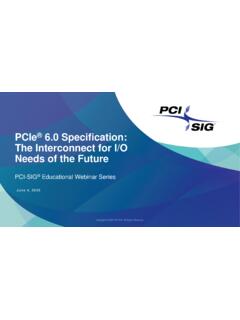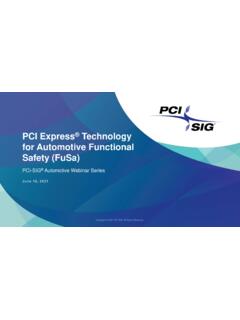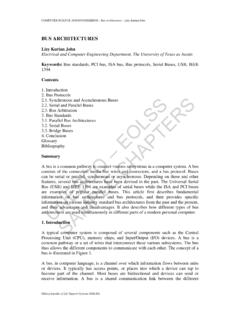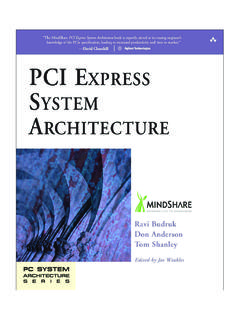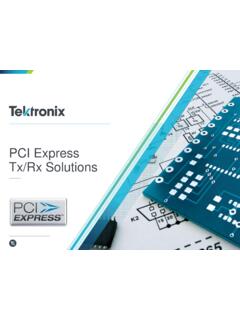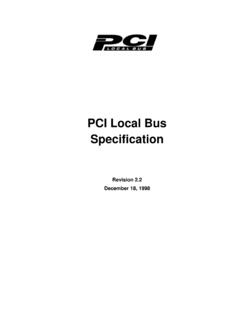Transcription of PCI Express Basics & Background
1 Copyright 2014, PCI-SIG, All Rights Reserved1 PCI Express Basics & BackgroundRichard SolomonSynopsysPCIeTechnology Seminar2 AcknowledgementsThanks are due to Ravi Budruk, Mindshare, Inc. for much of the material on PCI Express Basics2 Copyright 2014, PCI-SIG, All Rights ReservedPCIeTechnology SeminarAgenda PCI Express Background PCI Express Basics PCI Express Recent DevelopmentsCopyright 2014, PCI-SIG, All Rights Reserved3 PCIeTechnology Seminar4 PCI Express BackgroundCopyright 2014, PCI-SIG, All Rights ReservedPCIeTechnology SeminarCopyright 2014, PCI-SIG, All Rights Reserved5 Revolutionary AND Evolutionary PCI (1992/1993) Revolutionary Plug and Play jumperlessconfiguration (BARs) Unprecedented bandwidth 32-bit / 33 MHz 133MB/sec 64-bit / 66 MHz 533MB/sec Designed from day 1 for bus-mastering adapters Evolutionary System BIOS maps devices then operating systems boot and run without further knowledge of PCI PCI-aware O/S could gain improved functionality PCI (1995)
2 Doubled bandwidth with 66 MHz modePCIeTechnology SeminarCopyright 2014, PCI-SIG, All Rights Reserved6 Revolutionary AND Evolutionary PCI-X (1999) Revolutionary Unprecedented bandwidth Up to 1066MB/sec with 64-bit / 133 MHz Registered bus protocol Eased electrical timing requirements Brought split transactions into PCI world Evolutionary PCI compatible at hardware *AND* software levels PCI-X (2003) doubled bandwidth 2133MB/sec at PCI-X 266 and 4266MB/sec at PCI-X 533 PCIeTechnology SeminarCopyright 2014, PCI-SIG, All Rights Reserved7 Revolutionary AND Evolutionary PCI Express aka PCIe (2002) Revolutionary Unprecedented bandwidth x1: up to 1GB/sec in *EACH* direction x16: up to 16GB/sec in *EACH* direction Relaxed electricalsdue to serial bus architecture Point-to-point, low voltage, dual simplex with embedded clocking Evolutionary PCI compatible at software level Configuration space, Power Management, etc.
3 Of course, PCIe-aware O/S can get more functionality Transaction layer familiar to PCI/PCI-X designers System topology matches PCI/PCI-X (2006) doubled per-lane bandwidth: 250MB/s to 500MB/s (2010) doubled again to 1GB/ will double again to 2GB/s/lane!PCIeTechnology SeminarCopyright 2014, PCI-SIG, All Rights Reserved8 PCI ConceptsPCIeTechnology SeminarCopyright 2014, PCI-SIG, All Rights Reserved9 Address Spaces Memory & I/O Memory space mapped cleanly to CPU semantics 32-bits of address space initially 64-bits introduced via Dual-Address Cycles (DAC) Extra clock of address time on PCI/PCI-X 4 DWORD header in PCI Express Burstable I/O space mapped cleanly to CPU semantics 32-bits of address space Actually much larger than CPUs of the time Non-burstable Most PCI implementations didn t support PCI-X codified Carries forward to PCI ExpressPCIeTechnology SeminarCopyright 2014, PCI-SIG, All Rights Reserved10 Address Spaces Configuration Configuration space?
4 ?? Allows control of devices address decodes without conflict No conceptual mapping to CPU address space Memory-based access mechanisms in PCI-X and PCIe Bus / Device / Function (aka BDF) form hierarchy-based address (PCIe calls this Routing ID ) Functions allow multiple, logically independent agents in one physical device combination SCSI + Ethernet device 256 bytes or 4K bytes of configuration space per device PCI/PCI-X bridges form hierarchy PCIe switches form hierarchy Look like PCI-PCI bridges to software Type 0 and Type 1 configuration cycles Type 0: to same bus segment Type 1: to another bus segmentPCIeTechnology SeminarCopyright 2014, PCI-SIG, All Rights Reserved11 Configuration Space (cont d)ProcessorProcessorProcessorProcessorHo st/PCI BridgeBus = 0 Subord = 3 Host/PCI BridgeBus = 4 Subord = 5 MainMemoryPCI Bus 0 PCI Bus 1 PCI Bus 2 PCI Bus 4 PCI Bus 5 PCI-to-PCIB ridgePrimary = 0 Secondary = 1 Subord = 3 PCI-to-PCIB ridgePrimary = 4 Secondary = 5 Subord = 5 PCI-to-PCIB ridgePrimary = 1 Secondary = 2 Subord = 2 PCI Bus 3 PCI-to-PCIB ridgePrimary = 1 Secondary = 3 Subord = 3 Address PortData PortAddress PortData PortPCIeTechnology SeminarCopyright 2014, PCI-SIG, All Rights Reserved12 Configuration Space Device Identification VendorID: PCI-SIG assigned DeviceID: Vendor self-assigned Subsystem VendorID: PCI-SIG Subsystem DeviceID.
5 Vendor Address Decode controls Software reads/writes BARs to determine required size and maps appropriately Memory, I/O, and bus-master enables Other bus-oriented controlsPCIeTechnology SeminarCopyright 2014, PCI-SIG, All Rights Reserved13 Configuration Space Capabilities List Linked list Follow the list! Cannot assume fixed location of any given feature in any given device Features defined in their related specs: PCI-X PCIe PCI Power Management Etc. Capability IDPointer toNext CapabilityFeature-specificConfiguration Registers078153116 Dword nDword 1 Dword 0 PCIeTechnology SeminarCopyright 2014, PCI-SIG, All Rights Reserved14 Configuration Space Extended Capabilities List PCI Express only Linked list Follow the list! Cannot assume fixed location of any given feature in any given device First entry in list is *always* at 100h Features defined in PCI Express specificationCapability IDPointer to Next CapabilityFeature-specific Configuration Registers078153116 Dword nDword 1 Dword 01920 VersionPCIeTechnology SeminarCopyright 2014, PCI-SIG, All Rights Reserved15 Interrupts PCI introduced INTA#, INTB#, INTC#, INTD# -collectively referred to as INTx Level sensitive Decoupled device from CPU interrupt System controlled INTx to CPU interrupt mapping Configuration registers report A/B/C/D programmed with CPU interrupt number PCI Express mimics this via virtual wire messages Assert_INTx and Deassert_INTxPCIeTechnology SeminarCopyright 2014, PCI-SIG, All Rights Reserved16 What are MSI and MSI-X?
6 Memory Write replaces previous interrupt semantics PCI and PCI-X devices stop asserting INTA/B/C/D and PCI Express devices stop sending Assert_INTx messages once MSI or MSI-X mode is enabled MSI uses one address with a variable data value indicating which vector is asserting MSI-X uses a table of independent address and data pairs for each vector NOTE: Boot devicesand any device intended for a non-MSI operating system generally must still support the appropriate INTx signaling!PCIeTechnology SeminarCopyright 2014, PCI-SIG, All Rights Reserved17 Split Transactions Background PCI commands contained no length Bus allowed disconnects and retries Difficult data management for target device Writes overflow buffers Reads require pre-fetch How much to pre-fetch? When to discard? Prevent stale data? PCI commands contained no initiator information No way for target device to begin communication with the initiator Peer-to-peer requires knowledge of system-assigned addressesPCIeTechnology SeminarCopyright 2014, PCI-SIG, All Rights Reserved18 Split Transactions PCI-X commands added length and Routing ID of initiator Writes: allow target device to allocate buffers Reads: Pre-fetch now deterministic PCI-X retains retry & disconnect , adds split Telephone analogy Retry: I m busy go away Delayed transactions are complicated Split.
7 I ll call you back Simple More efficientPCIeTechnology SeminarCopyright 2014, PCI-SIG, All Rights Reserved19 Benefits of Split Transactions2550100125150175200225250275 Number of Load Exerciser Cards12345 Bandwidth MegaBytes/sec50%60%70%80%90%100%10%20%30 %40%Percent of Total Bandwidth2550100125150175200225250275 Number of Load Exerciser Cards2150%60%70%80%90%100%10%20%30%40%Pe rcent of Total BandWidthSystem Overhead--SchedulingTransaction Overhead --Addressing and RoutingTransaction Data Payload --Actual user dataIdle Time--Unused BWTransactionData Payload--Actual userdataIdle Time--Unused BWSystem Overhead--SchedulingTransaction Overhead --Addressing and RoutingBandwidth MegaBytes/secBandwidth Usage with Conventional PCI ProtocolsBandwidth Usage with PCI-X EnhancementsPCIeTechnology SeminarCopyright 2014, PCI-SIG, All Rights Reserved20 PCI Express BasicsPCIeTechnology SeminarCopyright 2014, PCI-SIG, All Rights Reserved21 PCI Express Features Dual Simplex point-to-point serial connection Independent transmit and receive sides Scalable Link Widths x1, x2, x4, x8, x12, x16, x32 Scalable Link Speeds , and (16GT/s coming in ) Packet based transaction protocolPCIeDeviceAPCIeDeviceBLink (x1, x2, x4, x8, x12, x16 or x32)PacketPacketPCIeTechnology SeminarCopyright 2014, PCI-SIG, All Rights Reserved22 LinkLanePCI Express TerminologyPCI Express Device APCI Express Device BSignalWirePCIeTechnology SeminarCopyright 2014, PCI-SIG, All Rights Reserved23 PCI Express ThroughputDerivation of these numbers: 20% overhead due to 8b/10b encoding in and Note.
8 ~ overhead due to 128/130 encoding not reflected above in and Bandwidth (GB/s)Link GT/s 5 GT/s 8 GT/s 16GT/s 2481632 PCIeTechnology SeminarCopyright 2014, PCI-SIG, All Rights Reserved24 Additional Features Data Integrity and Error Handling Link-level LCRC Link-level ACK/NAK End-to-end ECRC Credit-based Flow Control No retry as in PCI MSI/MSI-X style interrupt handling Also supports legacy PCI interrupt handling in-band Advanced power management Active State PM PCI compatible PMPCIeTechnology SeminarCopyright 2014, PCI-SIG, All Rights Reserved25 Additional Features Evolutionary PCI-compatible software model PCI configuration and enumeration software can be used to enumerate PCI Express hardware PCI Express system will boot PCI OS PCI Express supports PCI device drivers New additional configuration address space requires OS and driver update Advanced Error Reporting (AER)
9 PCI Express Link ControlsPCIeTechnology SeminarCopyright 2014, PCI-SIG, All Rights Reserved26 PCI Express TopologySwitchPCIeEndpointLegacyEndpoint PCIeEndpointRoot ComplexCPUPCIe 1 MemoryPCIeBridge ToPCIe 6 PCIe 7 PCIe 4 PCIe 5 LegendPCI Express Device Downstream PortPCI Express Device Upstream Port PCIeEndpointSwitchVirtualPCIB ridgeVirtualPCIB ridgeVirtualPCIB ridgeVirtualPCIB ridgePCI/PCI-XPCI/PCI-XBus 2 PCIe 3 Bus 8 Bus 0 (Internal)PCIeTechnology SeminarCopyright 2014, PCI-SIG, All Rights Reserved27 Request are translated to one of four transaction types by the Transaction Read or Memory Write. Used to transfer data from or to a memory mapped location. The protocol also supports a locked memory readtransaction Read or I/O to transfer data from or to an I/O location. These transactions are restricted to supporting legacy endpoint Read or Configuration Write.
10 Used to discover device capabilities, program features, and check status in the 4KB PCI Express configuration like posted writes. Used for event signaling and general purpose Types,Address SpacesPCIeTechnology SeminarCopyright 2014, PCI-SIG, All Rights Reserved28 Each request or completion header is tagged as to its type, and each of the packet types is routed based on one of three schemes: Address Routing ID Routing Implicit Routing Memory and IO requests use address routing Completions and Configuration cycles use ID routing Message requests have selectable routing based on a 3-bit code in the message routing sub-field of the header type fieldThree Methods For Packet RoutingPCIeTechnology SeminarCopyright 2014, PCI-SIG, All Rights Reserved29 Programmed I/O TransactionProcessorProcessorRoot ComplexDDR SDRAME ndpointEndpointEndpointEndpointEndpointS witch ASwitch C Switch BFSBMRdMRdMRdCplDCplDCplDRequester:-Step 1.




